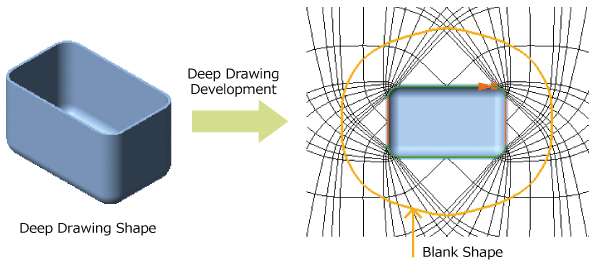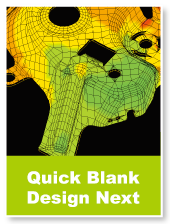QUICK BLANK DESIGN Next has two blank development methods: "ONE-STEP (the shape to target is different)" method and "Slip-line Field" method.
"ONE-STEP" method can be applied to all-round complex shape with relatively shallow depth. "Slip-line Field" method can be applied to the deep drawing with relatively simple shape.
Blank Development by ONE-STEP Method
Although the various methods are developed to calculate a blank shape, Quick Blank Design Next has adopted a method called "ONE-STEP" method. This program is the first domestically produced blank development solution by Advanced Simulation Technology Of Mechanics R&D, Co. Ltd (FEM Solver) and CAMTUS, Inc (Pre/Post Processors).
- Calculate the blank shape and area quickly for the estimation.
- Adopt the mixed mesh (quadrilateral and triangular) for splitting a mesh. In the FEM analysis of thin plate structures, you can obtain the better calculation result if you split the mesh based on the quadrilateral mesh.
- In case of 3D data like IGES, receiving the defective date coming from the upstream process is not uncommon. Therefore, frequently-used modeling tools to modify the curved surface data are equipped. (Stand-alone type)
- Direct loading of IGES, Parasolid, and DesignBase format data
- CATIA v5, CATIA v4, STEP, and SAT format are optional.
Slip-line Field Method
Perform the inverse analysis using the slip-line field theory. A blank shape of a blanking and drawing or a deep drawing with flanges, and a blank shape of multistage deep drawing can be calculated by considering the anisotropy. The circumferential ratio of die and blank is reported, so that you can consider whether the deep drawing is available or not.





